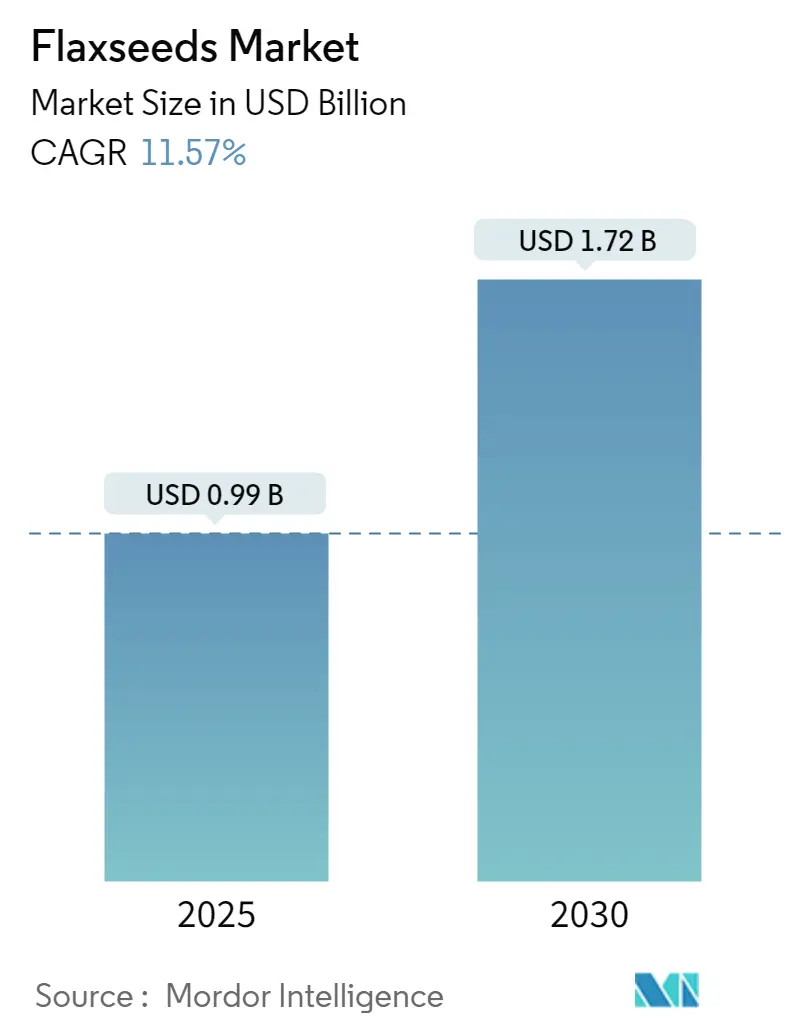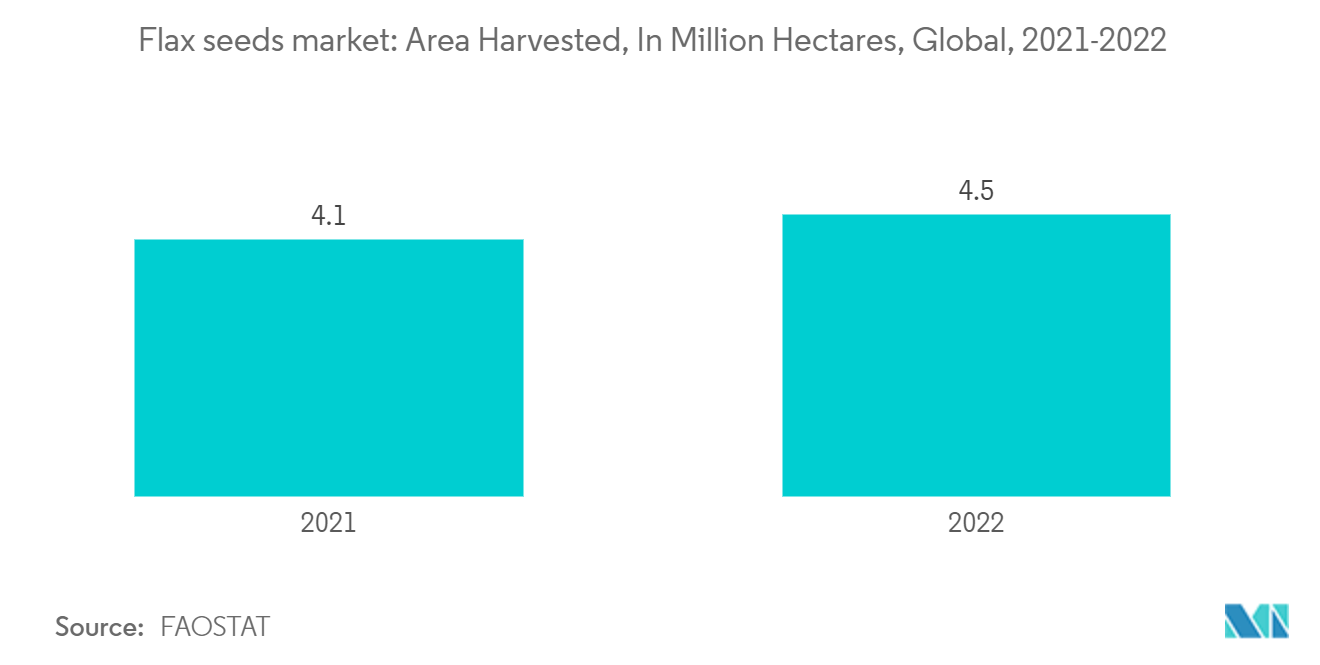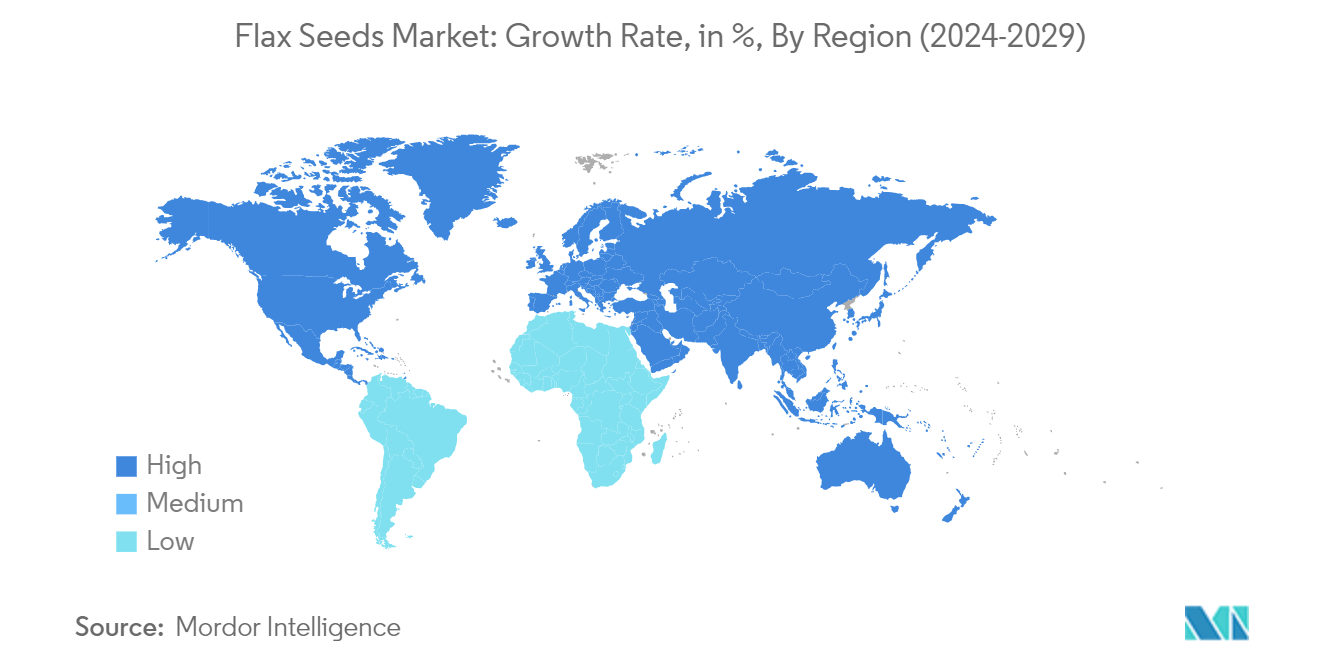
| Study Period | 2019 - 2030 |
| Base Year For Estimation | 2024 |
| Market Size (2025) | USD 0.99 Billion |
| Market Size (2030) | USD 1.72 Billion |
| CAGR (2025 - 2030) | 11.57 % |
| Fastest Growing Market | North America |
| Largest Market | Asia-Pacific |
Flaxseeds Market Analysis
The Flaxseeds Market size is estimated at USD 0.99 billion in 2025, and is expected to reach USD 1.72 billion by 2030, at a CAGR of 11.57% during the forecast period (2025-2030).
- Flax seeds, also known as linseed, are an annual herbaceous crop and gained popularity worldwide in recent years due to health benefits and commercial usage. Flax seeds are mainly used for edible purposes such as food and oil and in various beverages. For instance, in 2022, Scaler Bakery introduced a new flax seed-based product known as Golden Flax Seed Scala Bread. Flax seeds have also been used in textile industries over the past few years. In the global market, flax seeds can be used for crushing, which results in oil and flax meal production. It can also be used in the form of whole seeds, roasted, sprouted, and grounded seeds. The wide usage of flax seeds is one of the major factors boosting its market across the world.
- The rise in plant-based diets and veganism has increased the demand for plant-derived sources of nutrients. Flax seeds are an attractive option for those seeking alternative sources of omega-3 fatty acids, traditionally obtained from fish. This shift has led to a surge in flax seed consumption and its incorporation into various products like milk, smoothies, cereals, and snacks made of flax seeds. In 2022, Malibu Mylk, a California-based non-dairy beverage brand, introduced Flax Milk, produced from whole and organic flax seeds, to the US market. The product is allergen-free and is the best plant-based milk. This product is encouraged for use by the vegan population, thereby aiding the market's growth.
- Furthermore, Kazakhstan, Russia, Canada, China, India, the United Kingdom, and the United States are some of the leading countries in global flax seed production. Furthermore, flax seeds are a cheaper alternative to chia seeds and quinoa seeds for animal feed and industrial purposes, which is increasing global production. As per FAOSTAT, flax or linseed production grew from 3.3 million metric tons in 2021 to 3.9 million metric tons in 2022. Therefore, the increasing usage of flax seeds due to their health benefits and growing usage for industrial purposes driving global production are some of the factors that are anticipated to drive the flax seed market.
Flaxseeds Market Trends
Rising Popularity of Super Foods
The popularity of super ingredients has increased significantly over the recent past as consumers are more inclined toward natural and wholesome ingredients. These products have superior nutritional value as they are rich sources of polyphenols, antioxidants, vitamins, and minerals. Due to the high dietary fiber content of flax seeds, antioxidants, and protein, regular consumption of flax seeds helps in good digestive functioning. Additionally, flax seed is one of the world's richest known plant sources of omega-3. It naturally contains 40% oil, of which 55% is Omega-3 essential oil that benefits both animals and humans, improving metabolic processes, stamina, immunity, etc. Furthermore, the increased availability of superfoods, including flax seeds in supermarkets, traditional grocery stores, and convenience stores, has also supported the market for flax seeds in developing countries over the past few years.
The increasing demand for flax seeds is causing them to compete with other superfoods such as chia seeds, hemp seeds, and quinoa. This competition is affecting the pricing strategies, leading to higher prices and contributing to the market's growth. According to the United States Bureau of Labor Statistics, the producer price index for flax seeds rose from 219.6 in April 2019 to 263.1 in April 2024. This increase in price index, along with the rising demand for the produce, is enhancing the market value of flax seeds, thereby propelling the market.
Moreover, as global demand for flax seeds surges, producers are expanding cultivation areas to meet this rising demand. According to FAOSTAT, the harvested area of flax seed increased from 4.1 million hectares in 2021 to 4.5 million hectares in 2022 across the world. Therefore, the increasing demand for flax seeds due to associated health benefits and usage as superfoods, along with rising production areas and growing prices, is anticipated to drive the flax seed market.

Asia-Pacific is Expected to Lead the Flax Seeds Market
Asia-Pacific is the largest flaxseed-producing region in the world. The trend toward preventive healthcare and natural remedies has led to a greater emphasis on incorporating superfoods like flax seeds into daily diets. This has pushed renowned brands to launch new products, thereby aiding the market's growth. In 2021, India Gate Basmati Rice, India's first integrated rice brand, launched two new additions in the domestic market to its healthy foods branded portfolio, namely Wholesome Health Special Chia Seeds and Active Heart Special Roasted Flax Seeds. This kind of product launch targets health-conscious customers, thereby aiding the market's growth.
Kazakhstan, China, India, Australia, and Iraq are the major producers and consumers of flax seeds in the region. Kazakhstan alone accounts for about 33.8% of the total harvested area, with over 1.34 million hectares in 2022, according to the FAOSTAT. The rising production globally and growing demand for flax seeds have increased its export potential over the past few years, which is supporting the market's growth. According to the ITC Trade Map, the value of linseed exports in Kazakhstan has increased by over 26.8% between 2019 and 2023, reaching USD 227 million in 2023. This rising export value is expected to support the market for flax seeds in the coming years.
Along with this, Asia-Pacific is also the largest consumer of flax seeds due to the presence of large populated and developing countries such as India and China. This supports the imports of the produce in the countries, thereby aiding the consumption. As per the ITC trade map, the imports of flax seed grew from 614,570 metric tons in 2022 to 1,220,034 metric tons in 2023. The demand is further anticipated to increase due to the rise in disposable incomes and the increasing demand for healthy foods in the region in recent years. Therefore, the increasing export value of flax seeds, consumption, and rising disposable incomes are anticipated to drive the flax seed market.

Flax Seeds Market News
- June 2024: Biogin Biochemicals, a Shengdu-based company, received a patent for its standardized flax seed extract, AlaLife Flax Lignan. This patent will be useful in developing its international presence in the foods, beverages, and cosmeceuticals sectors.
- January 2022: Scoular, a global agri-food company, opened its new high-speed flax processing facility in Regina, Western Canada. The new facility helps the company increase its supply capacity and produces whole and milled flax, which is available in golden or brown categories.
Flaxseeds Industry Segmentation
Flax seeds are fiber crops obtained from the flax or linseed plant. The flax seeds market is segmented by geography (North America, Europe, Asia-Pacific, South America, and Middle East and Africa). The report includes the production analysis (volume), consumption analysis (value and volume), export analysis (value and volume), import analysis (value and volume), and price trend analysis. The report also offers the market size and forecasts for value (USD) and volume (metric tons) for all the above segments.
| Geography | North America | United States | |
| Canada | |||
| Mexico | |||
| Europe | Germany | ||
| United Kingdom | |||
| France | |||
| Russia | |||
| Spain | |||
| Asia-Pacific | Kazakhstan | ||
| China | |||
| Japan | |||
| India | |||
| South Korea | |||
| South America | Brazil | ||
| Argentina | |||
| Middle East and Africa | South Africa | ||
| Saudi Arabia | |||
| United Arab Emirates | |||
| Egypt | |||
Flax Seed Market Research FAQs
How big is the Flaxseeds Market?
The Flaxseeds Market size is expected to reach USD 0.99 billion in 2025 and grow at a CAGR of 11.57% to reach USD 1.72 billion by 2030.
What is the current Flaxseeds Market size?
In 2025, the Flaxseeds Market size is expected to reach USD 0.99 billion.
Which is the fastest growing region in Flaxseeds Market?
North America is estimated to grow at the highest CAGR over the forecast period (2025-2030).
Which region has the biggest share in Flaxseeds Market?
In 2025, the Asia-Pacific accounts for the largest market share in Flaxseeds Market.
What years does this Flaxseeds Market cover, and what was the market size in 2024?
In 2024, the Flaxseeds Market size was estimated at USD 0.88 billion. The report covers the Flaxseeds Market historical market size for years: 2019, 2020, 2021, 2022, 2023 and 2024. The report also forecasts the Flaxseeds Market size for years: 2025, 2026, 2027, 2028, 2029 and 2030.
Our Best Selling Reports
Flax Seed Industry Report
Statistics for the 2025 Flaxseeds market share, size and revenue growth rate, created by Mordor Intelligence™ Industry Reports. Flaxseeds analysis includes a market forecast outlook for 2025 to 2030 and historical overview. Get a sample of this industry analysis as a free report PDF download.




